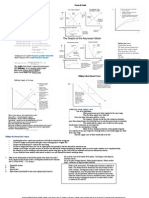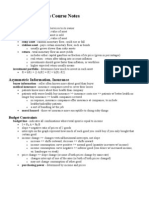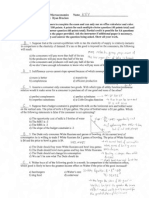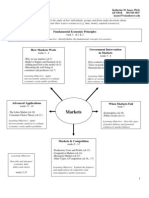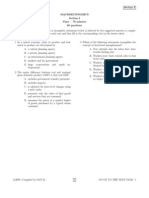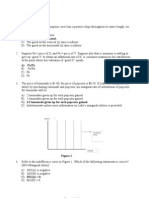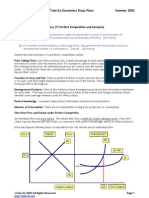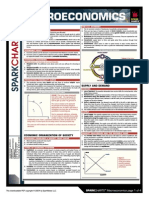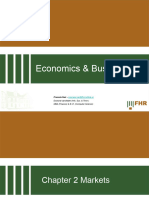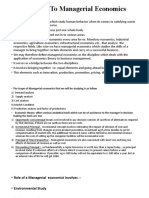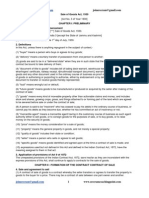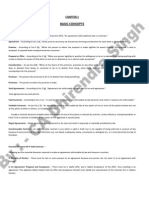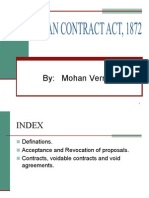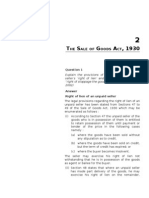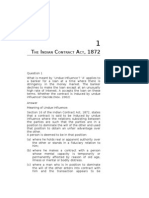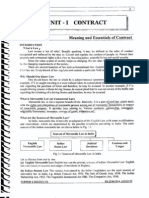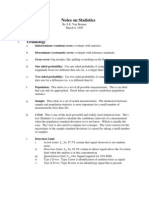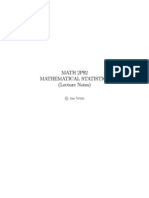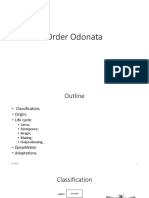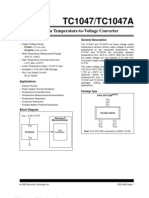Microeconomics
Microeconomics
Uploaded by
Vishal GattaniCopyright:
Available Formats
Microeconomics
Microeconomics
Uploaded by
Vishal GattaniOriginal Description:
Copyright
Available Formats
Share this document
Did you find this document useful?
Is this content inappropriate?
Copyright:
Available Formats
Microeconomics
Microeconomics
Uploaded by
Vishal GattaniCopyright:
Available Formats
Prepared by Mattupalli Associates
For Master Minds, No.1 for CA/CWA, Ph:0863-2242355
CHAPTER 1 : DEMAND
Desire + ability to pay+Willing to buy = Demand
Determinants of demand
Types of Demand Price demand Price Demand Income demand Cross demand
4Price of commodity(P#$-D$#) 4Price of related commodities:
- Substitutes (P#$-D#$) -Complementaries (P#$-D$#) 4Income of consumers (I#$-D#$)
#$
#$
Substitutes
Complementaries Price of Petrol Demand for car
A ss oc ia te s
Superior goods Income
Inferior goods Demand
4Tastes & Preferences of
Consumers(Fav-D#,Unfav-D$) 4Population(Pop#-D#,Pop$-D$)
Price of Tea
Demand for coffee
Demand
Income
#$
Y
D P1 Price of Tea P
#$
#$
Price of Petrol P
Y D
$#
#$
Y
#$
I D
#$
Y
$#
pa lli
4Climate & Weather (Fav-D#,Unfav-D$) 4Gov't Policies(Fav-D#,Unfav-D$) 4Expectations about future prices
Law of Demand
P1
I1
D O Q Q1
Demand for Coffee
I1 I
D O X Q Q1 Demand for Cars
I
Income
Income
Demand
D D
D X
Changes in demand Caused by Change in price Extension & contraction Movement along the same demand curve Change in quantity demanded Y
P1
Q1
Q1
Demand
M at tu
Caused by Change in other factors Increase & Decrease Shift in the demand curve Change in demand Increase
Y
D D1
Assumptions All the determinants of demand are assumed to be constant except price
Exceptions
4Giffen's paradox
(Generally inferior goods) Demand curve-back ward bending 4Articles of distinction (Veblen goods) 4Demonstration effect
Importance Useful to: 4Farmers
Reasons for downward sloping demand curve
4Finance Minister 4Consumer 4Monopolist
(In determination of Price)
4Future expectations
about prices 4Irrational consumer
4New Buyers 4Old Buyers 4Income effect 4Substitution effect
Decrease
Y D2 D
#
Price P P2 0,0 Q1
$
P Price
P Price
D1 D Q Q1 Quantity
D2
Q Q2 Quantity
Q2
Quantity
Fast Track Material for Micro Economics
Page 1
Dont dare to copy. Copy rights reserved.
Prepared by Mattupalli Associates
For Master Minds, No.1 for CA/CWA, Ph:0863-2242355
CHAPTER 2 : ELASTICITY OF DEMAND
Price elasticity of demand Income elasticity of demand Formula
% C h a n g e in d e m a n d % C h a n g e in in c o m e Dq y Dy q
Degrees 1) Perfectly elastic( )
8
Y Price of the Commodity Ed=
Methods 1) Point Method dq p Ep = x Or dp q Ed = lower segment Upper segment
Y D
Ed= Ed>1
Factors 1) Availability of Substitutes [If Available - Elastic If not Available - Inelastic] 2) Type of want [Necessary - Inelastic Comforts, luxuries - Elastic]
Importance/uses
4Useful to business firms 4Determination of Price &
output
= =
Q1
Quantity Demanded
2) Perfectly inelastic (0)
Y Ed=0 Price of the Commodity P1 P P2
A ss oc ia te s
Ed=1 Ed<1
Q Quantity Demanded
3) Consumer habits [Habitual consumers - Inelastic Others - Elastic]
Ed=0
4Determination of prices 4Useful to super markets 4Useful to finance minister 4Pricing factors of production 4Explains the paradox of plain 4Useful in foreign exchange
Degrees Negative (<0) -Inferior goods Positive (>0) - Superior goods 0 to 1 - Necessaries >1 - comforts/ luxuries
Price
3) Unitary elastic (1)
Quantity
d X
2) Percentage Method Ed = % Change In demand % Change in price 4) Relatively elastic (>1)
M at tu
4) No of purposes (uses) [Can be used -elastic Cant be used -inelastic] 5) Price Range [Very high /low -inelastic Middle range-elastic] 6) Postponement [Yes- elastic No -inelastic]
pa lli
theory
rates
Dq p Dq p = q Dp Dp q
3) Arc Elasticity Method
4Nationalising an industry Cross elasticity of demand 4Granting protection to
industry Degrees Negative (<0) - Complementaries Positive (>0) - Substitutes Zero - Unrelated goods/ Independent goods
q - q1 p + p2 Ed = 2 1 p 2 - p1 q1 + q 2
5) Relatively In elastic (<1) 4) Total out lay Method Price T.Exp
Formula 7) Proportion of Expenditure [Small -inelastic High -elastic]
EC = =
#$ #$ #$
$# (Ed >1) #$ (Ed <1) Same(Ed =1)
Page 2
% C h a n g e in d e m a n d o f x % C h a n g e in p r ic e o f y py Dq x Dp y qx
Fast Track Material for Micro Economics
Dont dare to copy. Copy rights reserved.
Prepared by Mattupalli Associates
For Master Minds, No.1 for CA/CWA, Ph:0863-2242355
CHAPTER 3: SUPPLY & ELASTICITY OF SUPPLY
SUPPLY
Elasticity of supply
Determinants
4Prices of Products 4Prices of related commodities 4Prices of factor of 4Government policy 4Business policy 4Time 4Agreement among producers
production
Exceptions to law of supply
Degrees of price elasticity of supply
Determinants
)
Importance
Measurements
4Auction sale
in future
4Fear of fall in prices 4Perfectly inelastic supply (=0) 4Rare commodities 4Land 4Supply of labour
A ss oc ia te s
4Perfectly elastic supply (=
4State of technology
4Relatively inelastic supply (<1) 4Relatively elastic supply (>1) 4Unit elastic supply (=1)
(=0)
4Nature of commodity 4Effect of price 4Time 4Quasi rent 4Techniques of production 4Better for 4Estimates of future
Changes in supply
4Point elasticity
Es = Dq p Dp q
4Arc elasticity
Es = q 2 - q1 p + p2 1 p 2 - p1 q1 + q 2
pa lli
(<1)
Caused by change in price
Caused by change in other factors Increase & decrease Shift in the supply curve Change in supply Increase
S S1 P Price
Price M at tu
(=1)
(>1) (= )
Extension & contraction Movement along the same supply curve Change in quantity supplied
S P1 Price
Quantity
Decrease
S2 P Price S
P P2 S Q2 Q Q1
S1 Q Quantity Q1
S2
S Q Quantity Q1
Quantity
Fast Track Material for Micro Economics
Page 3
Dont dare to copy. Copy rights reserved.
Prepared by Mattupalli Associates
For Master Minds, No.1 for CA/CWA, Ph:0863-2242355
CHAPTER 4: THEORY OF CONSUMERs BEHAVIOUR
UTILITY
Cardinal (1,2,3...) Marginal Utility analysis developed by Marshall
MU n = TU n - TU n -1 = TU n +1 - TU n = DTU DQ
Ordinal (I, II, III........) Indifference curve Analysis developed by Hicks & Allen
Assumptions
Properties Indifference curve: - slopes downwards from left to right -are always convex to origin -can never intersect with each other -do not meet the axes -need not be parallel to each other -higher indifference curve gives higher level of satisfaction than lower one
Superiority
Assumptions: 4Measurability of utility
substitution
4Marginal utility of money is constant 4Independent utility
4Assumption of consistency 4More units, more preference 4Scale of preference is
Marginal Utility Analysis
M at tu
pa lli
A ss oc ia te s
4Rational consumer 4Scale of preference 4Diminishing marginal rate of
4Assumptions are near to reality 4Non measurability of utility 4Marginal utility of money is not constant 4Explain cause for Giffen Goods 4Two commodity model 4Marginal rate of Substitution
Law of Diminishing Marginal Utility
Law of Equi-Marginal Utility
Assumptions
Importance
MU a MU b MU n = = ... = = MU of money Pa Pb Pn
Assumptions Importance
Theory of consumers surplus Consumers surplus=Willing price-Actual price Criticisms Importance
4Standard Units 4Identical Units 4No time interval 4No change in tastes & habits 4Some goods of special
Nature 4Availability of substitutes &
4Price determination 4Finance minister 4Explains paradox of
value 4Basis for economic laws 4Advantage to
4Indivisibility of goods 4Ignorance 4Unlimited resources 4Customs & fashions 4Measurability of Utility 4Constant utility of money
Page 4
4Consumption 4Production 4Exchange 4Distribution 4Government
4Imaginary 4Measures mental
satisfaction
4Price determination 4Useful to finance
minister
4Difficult to calculate willing
price
4Price discrimination
in discriminating monopoly 4Understanding the Water-diamond paradox 4Assessment of
4Marginal utility of money is
not constant
4Apply only in inflation 4Prestigious goods 4Changes from person to
Fast Track Material for Micro Economics
Dont dare to copy. Copy rights reserved.
Prepared by Mattupalli Associates
For Master Minds, No.1 for CA/CWA, Ph:0863-2242355
CHAPTER 5: PRODUCTION
LAND Features CAPITAL ORGANISER
A ss oc ia te s
4Free gift of nature 4No cost of production 4Limited in supply 4Permanent 4Land has no mobility 4Land is heterogenous 4Land has multiple uses 4Land is a specific factors
of production
Features Capital is - result of labour - result of savings - productive - temporary - mobile factor - a passive factor - not a free gift
Functions
4Provides subsistence 4Provides employment 4Provides raw materials 4Provides means of transport 4Provides tools & machines 4Increases labour Productivity
Different possible objectives
Problems Problems relating to -objectives -location & size of plant -finance -organization structure -marketing -legal formalities -industrial relations -selecting & organising physical activities
Qualities
4Organic 4Economic 4Social 4Human
4Far- sightedness 4courage 4leadership 4organising the
labour
4experience 4Knowledge of
business
pa lli
4Land is subject to law
Capital formation
M at tu
4Moral quality 4knowledge of
Functions
Forms of Capital
4Real capital & human capital 4Individual capital & Social Capital 4Fixed capital & Circulating capital 4Tangible capital & Intangible capital 4Sunk capital & floating capital 4Internal capital & external capital
4Initiating a business enterprise &
resource co-ordination
Stages
Factors
4Savings 4Mobilization of savings 4Investment of savings
4Ability to save 4Willingness to save
a) Family affection b) Prudence, c) Habit, d) Social status
4Facilities to save 4Security 4Rate of interest 4Taxation
Fast Track Material for Micro Economics
4Risk bearing or uncertainty bearing 4Innovations 4Organizing the business 4Managing the business 4Allocation of income 4Decision making
Page 5
Dont dare to copy. Copy rights reserved.
Prepared by Mattupalli Associates
Labour
For Master Minds, No.1 for CA/CWA, Ph:0863-2242355
Features Labour- Means human exertion - Power is co-extensive - Is perishable -Involves intelligence and judgement -Is inseparable from labourer -Has weak bargaining power -Power differs from labourer to labourer -Efficiency of labour can increased Occupational (One job to another job in the same industry) Type
Mobility of Labour
Factors affecting efficiency of Labour Factors
Types
ADVANTAGES
M at tu
pa lli
Horizontal Vertical (In the same (Lower grade to -Make choice between hours of labour & grade or at the higher grade) leisure same level) -Is less mobile than other factors Division of Labour
A ss oc ia te s
Geographical (One place to another place)
4Family-bond 4Information & knowledge 4means of transport & communication 4Level of literacy 4Poverty of
labour
4Racial qualities 4Health & strength of workers 4Standard of Living 4Education 4Personal qualities 4Social & political security 4Chances of promotion 4Trade unions 4Labour Laws
DISADVANTAGES
LIMITATIONS
4Professional specialisation
(Auditors, Doctors, Engineers, Teachers, Carpenters)
4Specialisation by process
(Pins manufacturing)
4Territorial specialisation
(Cotton Mills in Gujarat, Cycle
4Increases production 4Employment opportunities 4Efficiency 4Saving in time 4Saving in tools 4Large scale production 4Best quality of product 4Possibility of Mechanization
4Monotony 4Loss of skill 4Mistake will multiply 4Loss of sense of responsibility 4Risk of job 4Hinders mobility of labour 4Difficulty in distribution of
4Extent of market 4Nature of demand 4Inventions 4Capital availability 4Technical knowledge 4Nature of Industry 4Labour availability
Fast Track Material for Micro Economics
Page 6
Dont dare to copy. Copy rights reserved.
Prepared by Mattupalli Associates
For Master Minds, No.1 for CA/CWA, Ph:0863-2242355
CHAPTER 6: COST ANALYSIS
Determinants of cost Components of cost Relation between Average cost & Marginal Cost
4Prices of factors of production
(If high- cost #, If low-cost $)
4Prime cost
(Direct material+direct wages+direct expenses)
4Average cost and Marginal cost can be calculated
from total cost
4Technology
(Advanced-cost$,If not-cost#)
4Production overheads
(Indirect material+indirect wages+indirect expenses)
A ss oc ia te s
4Direct costs
4Size of plant
(Big-cost$, small-cost#)
4When Average cost falls Marginal cost also falls 4When Average cost rises Marginal cost also raises 4Marginal cost cuts Average cost at its optimum
4Production cost
4Capacity Utilization or output level
(Output level#-cost#, output level $-cost$)
(Prime cost+production over heads)
4Period
(Short run-cost#, long run-cost$)
4Cost related to other functions
distribution over heads)
(Administrative over heads+selling over heads+
4Stability of output
(If stable-cost$, If unstable-cost#)
4Law of returns operating
(Diminishing returns-cost#, increasing returns-cost$)
4Managerial efficiency 4Implicit costs
(Earnings of factors of production belonging to organizer himself)
4Accounting costs
(All payments made by the entrepreneur to the suppliers of various factors of production)
4Outlay costs
(Actual outlay of funds like wages, material, rent)
M at tu
Different types of costs
pa lli
4Total cost
4Shutdown costs
(Cost incurred after closing down of the business)
4Money costs
(Payment made to factors of production & other expenses)
(Identified & traced to a particular product)
4opportunity costs
(Cost related to foregone
4Indirect costs
(Can not be identified & traced to a particular
4Abandonment costs
(Cost related to retirement of fixed asset from use)
4Explicit costs
(Remuneration paid to outside factors of
4Economic costs
(Accounting cost {explicit}
4Real costs
(Pains & sacrifices of labour or efforts &
Fast Track Material for Micro Economics
Page 7
Dont dare to copy. Copy rights reserved.
Prepared by Mattupalli Associates
For Master Minds, No.1 for CA/CWA, Ph:0863-2242355
CHAPTER7: PRODUCTION ANALYSIS
PRODUCTION FUNCTION Short-Run Law of variable proportions [Fixed factors -constant Variable factors-vary] Assumptions 1st stage output > Input Reasons Long Run (All factors are variable) Law of returns to scale 2nd stage output = Input Reasons 3rd stage Assumptions of production function
Features
4Substitutability 4Complementary
4Capital can be increased
or decreased
4Production function
implies to a given
fixed
A ss oc ia te s
output < Input Reasons
4State of technology is constant 4Some inputs are kept to be 4Law does not apply if they
Y
90
Economies Internal External
Stage I
Stage II M
Stage III
Point of Inflexion I
TP
30
40
scale will not continue
pa lli
4Indivisibility 4Specialization 4Dimensional
4Exists in short period
only
Output
50
60
4Balancing 4Increasing returns to
4Expansion 4Entrepreneur 4Decreasing returns
4Technical :
-Big machines -Bye- products -Research -Specilisation -Linking process -Workshops
4Cheaper source of raw
materials & capital equipment
70
80
M at tu
10
Diseconomies
4Technical economies 4Development of skilled
labour
20
R
1 2 3 4 5 6 7 8
N
9 10
AP
11
Amount of variable factor
MP
Internal
External
4Managerial
4Growth of ancillary
industries
1st stage Law of increasing returns Reasons
2nd stage Law of diminishing returns Reasons
3rd stage Law of negative returns Reasons
4Inefficient
management
4Pollution 4Strains on
infrastructure
4Better transportation &
4Technical
difficulties
4Invisibility of fixed
Factor of production
4Distributing optimum
proportion
4Too much of variable
factors in relation to quantity of fixed Factor
4High factor
4Division of work &
4Imperfect substitutability
4Production 4Financial
Fast Track Material for Micro Economics
Page 8
Dont dare to copy. Copy rights reserved.
Prepared by Mattupalli Associates
For Master Minds, No.1 for CA/CWA, Ph:0863-2242355
CHAPTER8: MARKETS & CHAPTER 9 : PRICE &OUTPUT DETERMINATION
Features
Types
Factors effecting size of market
4Every market have some
commodities On the basis of area Basis of competition Basis of period of time
4Wide demand (If - Yes#, If -No$) 4Adequate supply (If - Yes#, If -No$) 4Very short period Market 4Durability (If - Yes#, If -No$) 4Portability(If - Yes#, If -No$) (supply is more or less
fixed)
4Competition 4Area
4Local market
( buyers & sellers carry on business in a particular locality)
4Perfectly competitive
Market (large number of sellers selling homogeneous products)
A ss oc ia te s
4Grading and sampling
(If - Yes#, If -No$)
4Short period market
(one can change variable factors only but not fixed factors)
4National market
(commodity is demanded and supplied all over the country)
4Monopoly
4Transport and communications
(If - Yes#, If -No$)
(single seller of the
control over the entire market)
pa lli
Commodity having full
4Long period market
(both fixed and variable factors can be changed)
4Level of income(If - high#, If -low$) 4Development of financial institutions
(If - Yes#, If -No$) -Availability of banks and other financial Institutions -Credit and banking habits of people etc
M at tu
4International market
4Imperfect Competition
(It is a combination of monopoly & perfect competition)
( commodity is demanded and supplied all over the
4Secular period Market
(changes can take place even in factors of
4Oligopoly
(only few sellers of a commodity each seller can influence the priceoutput policy of other
Fast Track Material for Micro Economics
Page 9
Dont dare to copy. Copy rights reserved.
Prepared by Mattupalli Associates
For Master Minds, No.1 for CA/CWA, Ph:0863-2242355
CHAPTER 10: PRICE & OUTPUT DETERMINATION UNDER DIFFERENT MARKETS
Perfect Competition Features Features Monopoly Monopolistic competition Features Sources Oligopoly Features
4Large number of buyers & Large
number of sellers
4Single seller of the product 4No close-substitutes 4Restrictions to entry 4Price maker 4Cant control supply & price
4Immobility of factors
of production
4Large number of
and seller
Buyers
4Product differentiation 4Control over price 4Freedom of entry or
exit
4Interdependence 4Importance of
advertising and selling costs
4Ignorance
A ss oc ia te s
4Products are homogeneous 4Free entry and free exist 4Perfect knowledge of the
conditions of firms market
4Indivisibility
4Deliberate policy of
4Group behaviour 4Indeterminateness of
demand curve
4Perfect mobility of factors
of Production
4Downward sloping demand
Features
M at tu
pa lli
Discriminating Monopoly
Degrees
4Difference in elasticity of demand 4Market imperfections 4Legal sanction 4Existence of monopoly
41st Degree
(In this the monopolist is able to sell each separate unit of his Product at different prices)
42nd degree
(In this buyers are divided into different groups and different price will be charged to different groups)
43rd degree
(In this seller divides his buyers into two or more than to sub markets & from each sub market a different price is charged)
Fast Track Material for Micro Economics
Page 10
Dont dare to copy. Copy rights reserved.
You might also like
- Microecon Cheat Sheet - FinalDocument3 pagesMicroecon Cheat Sheet - FinalDananana100100% (4)
- AP Macroeconomic Models and Graphs Study GuideDocument23 pagesAP Macroeconomic Models and Graphs Study GuideAznAlexT90% (21)
- Microeconomics 4th Edition-David BesankoDocument822 pagesMicroeconomics 4th Edition-David Besankoskangouras100% (10)
- 2000 AP Microeconomics Released ExamDocument17 pages2000 AP Microeconomics Released ExamJoseph Weng100% (3)
- Macro Final Cheat SheetDocument2 pagesMacro Final Cheat SheetChristine Son100% (1)
- AP Invoice Conversion in Oracle AppsDocument14 pagesAP Invoice Conversion in Oracle Appsshankar680No ratings yet
- Microeconomics Cue CardDocument4 pagesMicroeconomics Cue CardPaul FareseNo ratings yet
- Microeconomics SummaryDocument22 pagesMicroeconomics SummaryChristie Osarenren100% (1)
- 90,95,2000 Macro Multiple ChoiceDocument37 pages90,95,2000 Macro Multiple ChoiceAaron TagueNo ratings yet
- AP® Macroeconomics Crash Course, For the 2021 Exam, Book + Online: Get a Higher Score in Less TimeFrom EverandAP® Macroeconomics Crash Course, For the 2021 Exam, Book + Online: Get a Higher Score in Less TimeNo ratings yet
- Solutions 1Z0-404 Exam Practice Test - Online VersionDocument7 pagesSolutions 1Z0-404 Exam Practice Test - Online VersionPass4leads Exam50% (2)
- A level Economics Revision: Cheeky Revision ShortcutsFrom EverandA level Economics Revision: Cheeky Revision ShortcutsRating: 3 out of 5 stars3/5 (1)
- Essential Graphs For AP MicroeconomicsDocument5 pagesEssential Graphs For AP Microeconomicsjlvmrbd777100% (8)
- Introduction To Microeconomics, E201Document248 pagesIntroduction To Microeconomics, E201Al Beirão100% (6)
- AP Microeconomics TestDocument13 pagesAP Microeconomics TestGriffin Greco100% (1)
- Microeconomics Notes (Advanced)Document98 pagesMicroeconomics Notes (Advanced)rafay010100% (1)
- Economics Cheat SheetDocument5 pagesEconomics Cheat Sheetcaitobyrne341275% (4)
- Exercises in Measure of Central Tendency-Grouped and Ungrouped DataDocument3 pagesExercises in Measure of Central Tendency-Grouped and Ungrouped DataVishal Gattani93% (42)
- Unit 3 - Marketing Notes PDFDocument30 pagesUnit 3 - Marketing Notes PDFMinn Thiha ChitNo ratings yet
- DeviceNet 3HAC020676-001 - Revf - en PDFDocument136 pagesDeviceNet 3HAC020676-001 - Revf - en PDFedgard_gonzález_3No ratings yet
- AP Microeconomics Course NotesDocument37 pagesAP Microeconomics Course Notescandy_am05100% (4)
- Microeconomics Summary NotesDocument14 pagesMicroeconomics Summary NotesNg Chai SheanNo ratings yet
- Intermediate Microeconomics Exam 1Document6 pagesIntermediate Microeconomics Exam 1Chet GemaehlichNo ratings yet
- MicroEconomics Study NotesDocument12 pagesMicroEconomics Study Notesthiotakis100% (4)
- Principles of Microeconomics - SyllabusDocument10 pagesPrinciples of Microeconomics - SyllabusKatherine Sauer0% (1)
- AP Macroeconomics TestDocument10 pagesAP Macroeconomics TestTomMusic100% (1)
- Introduction To Microeconomics NotesDocument26 pagesIntroduction To Microeconomics NotesChristine Keh100% (2)
- Microeconomics Study Sheet Microeconomics Study Sheet: More Free Study Sheet and Practice Tests atDocument3 pagesMicroeconomics Study Sheet Microeconomics Study Sheet: More Free Study Sheet and Practice Tests atanandsemails6968100% (1)
- IB Macro Study GuideDocument19 pagesIB Macro Study GuidePaola Fernanda Montenegro100% (4)
- AP Macro Economics 2005 MCDocument14 pagesAP Macro Economics 2005 MCJames LiNo ratings yet
- Mock Test Questions Micro e ConsDocument10 pagesMock Test Questions Micro e Conscalz..100% (1)
- Microeconomics Notes For BeginnersDocument31 pagesMicroeconomics Notes For Beginnerssalmanahmed_hyd100% (3)
- Microeconomics HomeworkDocument16 pagesMicroeconomics HomeworkTaylor Townsend100% (1)
- Microeconomics HomeworkDocument14 pagesMicroeconomics HomeworkTaylor Townsend100% (3)
- Essay PlanDocument5 pagesEssay PlanΜιχάλης Θεοχαρόπουλος100% (2)
- MicroeconomicsDocument108 pagesMicroeconomicskesha100% (10)
- Sparkcharts: Macroeconomics Page 1 of 4Document4 pagesSparkcharts: Macroeconomics Page 1 of 4cpears56100% (1)
- Lecture Notes in MacroeconomicsDocument151 pagesLecture Notes in MacroeconomicsNghĩa CòiNo ratings yet
- Ch2 Marketing Feasibility StudyDocument120 pagesCh2 Marketing Feasibility StudyMosabAbuKhater67% (3)
- Week 4 Lecture Eco&BusDocument20 pagesWeek 4 Lecture Eco&BustimothyNo ratings yet
- Managerial Economics Chapter 4Document49 pagesManagerial Economics Chapter 4Ace PatriarcaNo ratings yet
- ECON6032 Managerial EconomicsDocument44 pagesECON6032 Managerial EconomicsDony SeNo ratings yet
- Demand Theory and Consumer Behaviour-Unit 2Document62 pagesDemand Theory and Consumer Behaviour-Unit 2sanalgupta1022No ratings yet
- Demand Analysis and Forecasting-1Document15 pagesDemand Analysis and Forecasting-1Rohit rajNo ratings yet
- Unit-1 MEFADocument31 pagesUnit-1 MEFABhaskhar ReddyNo ratings yet
- Economics PDFDocument12 pagesEconomics PDFStefano MarraNo ratings yet
- Economics PDFDocument12 pagesEconomics PDFStefano MarraNo ratings yet
- 9708 w14 Ms 21 PDFDocument7 pages9708 w14 Ms 21 PDFTan Chen Wui0% (1)
- CHAPTER 1 (Fundamental Concepts of Econ)Document2 pagesCHAPTER 1 (Fundamental Concepts of Econ)Vincere VjaNo ratings yet
- Vision: (Humanity' S Change Forever!)Document16 pagesVision: (Humanity' S Change Forever!)Rahul KaranNo ratings yet
- 2P The Demand For ResourcesDocument32 pages2P The Demand For ResourcesBett WesleyNo ratings yet
- DemandDocument48 pagesDemandash aNo ratings yet
- Summary F 13 PRTDocument56 pagesSummary F 13 PRTюрий локтионовNo ratings yet
- Managerial Economics: Cheat SheetDocument110 pagesManagerial Economics: Cheat SheetSushmitha KanasaniNo ratings yet
- Da Vinci Economics 1 - 2021 April - ND - FNB 2021 - First Two SessionsDocument22 pagesDa Vinci Economics 1 - 2021 April - ND - FNB 2021 - First Two SessionsMambo MkhizeNo ratings yet
- Minggu 4 - Present Worth Analysis - 12e XE-RevDocument36 pagesMinggu 4 - Present Worth Analysis - 12e XE-RevlisdhiyantoNo ratings yet
- 001-Economics LectureDocument126 pages001-Economics LectureAnisha DuttaNo ratings yet
- The Indian Contract Act 1872Document47 pagesThe Indian Contract Act 1872Dilfaraz KalawatNo ratings yet
- Pre Qs. PaperDocument48 pagesPre Qs. PaperSidharth Singh AntilNo ratings yet
- Sale of Goods Act 1930Document12 pagesSale of Goods Act 1930Vishal GattaniNo ratings yet
- Contract ActDocument5 pagesContract ActVishal GattaniNo ratings yet
- 43 - The Indian Contract Act 1872Document5 pages43 - The Indian Contract Act 1872Sanjeev Kumar TirthaniNo ratings yet
- Sale of Goods Act 1930Document12 pagesSale of Goods Act 1930Vishal GattaniNo ratings yet
- Law Contract Act. BasicnsDocument31 pagesLaw Contract Act. BasicnsVishal GattaniNo ratings yet
- Indian Contract ActDocument8 pagesIndian Contract ActjjmainiNo ratings yet
- Contract Act 1872Document38 pagesContract Act 1872Vishal GattaniNo ratings yet
- Chapter-3 The Indian Partnership Act, 1932Document22 pagesChapter-3 The Indian Partnership Act, 1932Vishal Gattani100% (8)
- Chapter-2 The Sale of Goods Act, 1930Document27 pagesChapter-2 The Sale of Goods Act, 1930Vishal GattaniNo ratings yet
- Chapter-1 The Indian Contract Act, 1872Document39 pagesChapter-1 The Indian Contract Act, 1872Vishal GattaniNo ratings yet
- Contract Act 1872Document69 pagesContract Act 1872Vishal GattaniNo ratings yet
- CPT Mercantile Law Dharmendra Madaan 3Document21 pagesCPT Mercantile Law Dharmendra Madaan 3Viswanathan Ramakrishnan50% (2)
- Statistc in ChemistryDocument13 pagesStatistc in Chemistrycinvehbi711No ratings yet
- Notes 424 03Document164 pagesNotes 424 03Muhammad Shafaat AwanNo ratings yet
- 0CPT Scanner (Paper2) Appendix Dec 09Document3 pages0CPT Scanner (Paper2) Appendix Dec 09Vishal GattaniNo ratings yet
- Stat Defn BookletDocument9 pagesStat Defn BookletVishal GattaniNo ratings yet
- Math Ratio & ProportionDocument4 pagesMath Ratio & ProportionVishal Gattani50% (2)
- Statistics 333Document84 pagesStatistics 333Vishal Gattani100% (1)
- CPT MathDocument2 pagesCPT MathVishal GattaniNo ratings yet
- Q2 Math3Document5 pagesQ2 Math3Yunilyn GallardoNo ratings yet
- OdonataDocument12 pagesOdonataJuste NavickaiteNo ratings yet
- Barfoeds TestDocument6 pagesBarfoeds TestcresNo ratings yet
- Celex 32020R1503 en TXTDocument49 pagesCelex 32020R1503 en TXTNuno Brito JorgeNo ratings yet
- TC1047 Data SheetDocument12 pagesTC1047 Data Sheetpacopaco45No ratings yet
- Free Download PDF ACI SP-067 Concrete Shell BucklingDocument5 pagesFree Download PDF ACI SP-067 Concrete Shell BucklingsipodiNo ratings yet
- Single Gas Detector Gas Alert Clip Extreme: Measurement MetersDocument4 pagesSingle Gas Detector Gas Alert Clip Extreme: Measurement MetersIsmaya SafetyNo ratings yet
- 2019 - Final Report &Statistics-CombinationDocument25 pages2019 - Final Report &Statistics-Combinationali morisyNo ratings yet
- UTS Syllabus For Summer ClassDocument11 pagesUTS Syllabus For Summer ClassOsannah Irish InsongNo ratings yet
- Simple Interest: Day: 74th - 75th Day: 74th - 75thDocument4 pagesSimple Interest: Day: 74th - 75th Day: 74th - 75thShivmNo ratings yet
- CALCULUS 2 - MODULE 3 - Lessons 17 19 - As of Nov 5Document57 pagesCALCULUS 2 - MODULE 3 - Lessons 17 19 - As of Nov 5Kim OpenaNo ratings yet
- Hfe Pioneer pdr-555rw ServiceDocument72 pagesHfe Pioneer pdr-555rw ServiceYannisNo ratings yet
- 37 Back Office Job Interview Questions (Plus Sample Answers)Document9 pages37 Back Office Job Interview Questions (Plus Sample Answers)Dario MiguelNo ratings yet
- Awaji AnalysisDocument65 pagesAwaji AnalysisVania Estrellita0% (1)
- Phychiatriccc NursingDocument24 pagesPhychiatriccc NursingNathaniel PulidoNo ratings yet
- Two-Phase Induction MachinesDocument15 pagesTwo-Phase Induction MachinesHania DogarNo ratings yet
- How To Find Credit Card Statement NameDocument3 pagesHow To Find Credit Card Statement Namephiliphenry522No ratings yet
- Price Floor, Ceiling and Elasticity CrosswordPrice Floor, Ceiling and Elasticity Crossword - WordMintDocument1 pagePrice Floor, Ceiling and Elasticity CrosswordPrice Floor, Ceiling and Elasticity Crossword - WordMintSandy SaddlerNo ratings yet
- Predator Prey ModelDocument5 pagesPredator Prey ModelAbdul Manaf100% (1)
- Specified Transmission Oils (Commercial Vehicle, Van) - Overview BB00.40-P-0231-02ADocument5 pagesSpecified Transmission Oils (Commercial Vehicle, Van) - Overview BB00.40-P-0231-02AСергій БоженкоNo ratings yet
- Eng. Farah. Spring 2022-2023design and Implementation of Decentralized VPN Using BlockchainDocument1 pageEng. Farah. Spring 2022-2023design and Implementation of Decentralized VPN Using Blockchainsarsor mansorNo ratings yet
- Fundamental Principle of CountingDocument19 pagesFundamental Principle of Countingcosmemargie730No ratings yet
- Math Demo Dec 2 2019 PrintDocument16 pagesMath Demo Dec 2 2019 PrintHazy Jade Hombrog RugaNo ratings yet
- 11 Yunai Den (Fushigi Yuugi Gaiden 11 - Chiriko)Document24 pages11 Yunai Den (Fushigi Yuugi Gaiden 11 - Chiriko)api-3706651100% (4)
- ST107 Exam Paper 2010Document12 pagesST107 Exam Paper 2010Alexis RheinNo ratings yet
- Conference Report PDFDocument6 pagesConference Report PDFSunil KushwahaNo ratings yet




